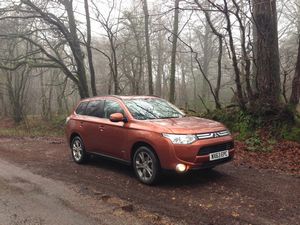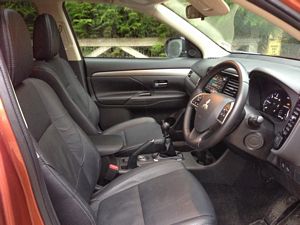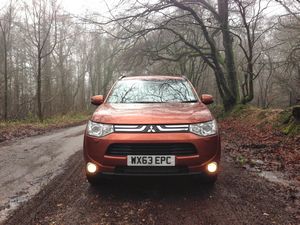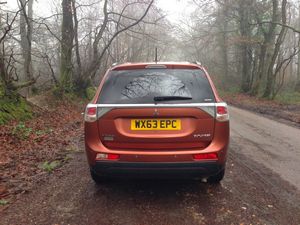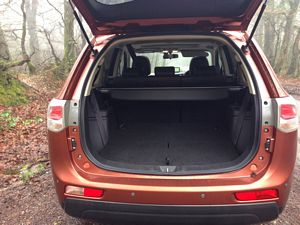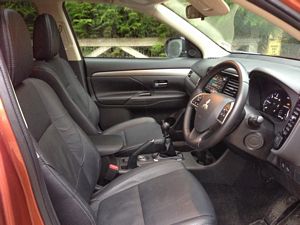|
By accessing or using The Crittenden Automotive Library™/CarsAndRacingStuff.com, you signify your agreement with the Terms of Use on our Legal Information page. Our Privacy Policy is also available there. |

2014 Mitsubishi Outlander 2.2 DI-D GX4 Review
|
|---|
|
|
2014 Mitsubishi Outlander 2.2 DI-D GX4 Review
Matt Hubbard
Speedmonkey
January 31, 2014
Matt Hubbard reviews the 2014 Mitsubishi Outlander in GX4 trim and with a manual gearbox
This, the third generation Outlander, was launched in February 2013. It's based on the Evo X chassis (unlike the previous model which was a shared Peugeot/Citroen effort) and has a Mitsubishi built 2.2 litre turbo diesel engine.
It's also 150kg lighter than the second generation and has much smoother bodywork in order to reduce drag. Add in a host of Eco measures and you get a class leading drag coefficient of 0.33Cd and an average 52.3mpg and 140 g/km of CO2.
In theory. I drove hundreds of miles in varying conditions and averaged 37mpg. On the motorway at a steady 70mph it'll do getting on for 40mpg but on country or urban roads expect 30mpg.
The test car had a 6-speed manual gearbox. I've previously driven an automatic Outlander and the gearbox in that was dementedly attuned to economy. The throttle had to be pressed hard to use any of its 147bhp. In a manual you can let rip and get the most out of the engine.
This makes for a more satisfying driving experience, albeit a more expensive one.
The whole point of the Mitsubishi Outlander is that it fills what was once a niche but that is now a huge market segment, that of the mid-sized, economical, spacious SUV. With its limited model range Mitsubishi kind of stumbled into the segment with the original Outlander, realised it was on to a good thing and continued to refine the car.
Largely it is a refined package, with a few grumbles to hinder the ownership experience.
It looks fine. Smooth flanks and a crease along the top of the doors. Foglights just fore of the front wheels give it a Tuscan Raider look. The rear end is resolutely SUV so you get the practicality that entails, good access to the rear and boot and decent visibility all round.
The boot has plenty of space, and a pair of seats under the floor for occasional, rather than permanent, use. You do have to open the boot yourself though without the luxury of automatic boot opening.
The driver and passenger get lots of space and storage. There are a total of ten cupholders in the Outlander plus deep door pockets, a space for a smartphone and a cubby hole under the armrest (which is too low and far back to actually use as an armrest).
The seats are supportive but not overly comfortable. I could vaguely feel the seat frame somewhere under me. They are electrically adjustable in this GX4 version but only for back and forward and rake. There's no lumbar support.
Distance to the pedals is ideal for most people and the steering wheel sits quite low for an SUV. In fact the passengers sit low in the car, with the window line at shoulder height.
The layout of the instrument binnacle and the various buttons and knobs is well thought out and at night the colours are generally a uniform red. It all looks very nice if you ignore the sea of black plastic. Any leather trim used is so close to looking and feeling like plastic it hardly seems worth the effort.
Black is the order of the day if you want an Outlander. You can't choose any other interior colour scheme.
The controls all feel as though they were tested a million times for reliability but no-one thought to improve them from an aesthetic point of view. Unlike an old Land Rover Freelander everything will still work in a 20 year old Outlander, but it will never look pretty inside.
The rear seats are not exactly comfortable (they could do with more padding) but offer a vast amount of legroom. There are yet more cupholders in the back but not much else aside from electric windows and an armrest (with cupholders in it).
The entertainment system is touted as being a 'Premium Nav/Audio system' but has no DAB digital radio and the smartphone functionality is immensely frustrating. It's very slow witted and takes an age to integrate with your phone via Bluetooth or cable. If you do hook your phone up to the cable it takes about three minutes to realise every single time you turn the ignition on.
So stop for fuel, then pull away, endure three minutes of silence and then the music comes back on.
The satnav is functional but not pretty looking. A small screen between the rev counter and speedo gives turn by turn directions. Postcode entry is frustrated by the fact you have to also enter the country and road name every time. A postcode covers a very small area so there should be no need for this extra info.
So far the Outlander looks quite nice and is spacious and practical with not much in the way of flair.
The driving experience is almost entirely positive. At 1,590kg and with 147bhp the Outlander can be a hoot to drive, for an SUV. The chassis is set up for road driving so the suspension smooths out lumps in the road whilst giving it a decent amount of road holding and cornering ability.
The steering is light and feedback not half bad. Even if you buy an Outlander for entirely economic and functional reasons you can still have some fun in it. Below 1300rpm there seems to be zero torque but keep the turbo spinning and it feels like all 280 lb ft of torque is available.
Spec a manual gearbox and you'll have much more fun than the frustratingly eco-orientated automatic version.
There is, however, a fly in the ointment. Getting it into third gear can be an almighty pain. Sometimes gearboxes are described as notchy, which can be a vague description. The Outlander's third gear actually has a notch. You simply cannot change from second to third quickly. If you try you will find yourself making two or three attempts to get it in gear.
The key is patience. From second allow the gear lever to find its natural position below third and then pop it up into gear. You kind of get used to it after a while but it still frustrates because the lower gears are very close. Second runs out of puff at about 50mph.
You find yourself taking traffic free roundabouts and tight corners in third gear and keeping the speed above 25mph or else the engine bogs down below the turbo threshold.
If you can live with this then the manual gearbox makes for a better drive than the automatic.
The GX4 trim as tested gets cruise control (although adaptive is only available on the GX5), xenon lights, a reversing camera, keyless entry, the 'premium' audio nav system and heated electric seats.
The four wheel drive system is flexible. You can choose front wheel drive for day to day use or 50:50 distributed four wheel drive for off-roading action - or an automatic selection which chooses how to utilise the system based on wheel slip.
On the road the Outlander is a pretty smooth cruiser with not much road or tyre noise and a pleasant driving position. I drove for 3 hours at night in the rain one evening and it transformed from a functional machine into a warm, safe cocoon with brilliant lights and easy to read instruments.
That's the key to the Outlander. It is quite big, it is quite economical, it is basically quite a functional, sensible car and, if you can put up with its foibles, you will enjoy owning it.
If I were to buy an Outlander I'd go for a GX3 which costs £27k and still has Bluetooth, auto lights and rain sensing wipers or a £34k GX5 which adds digital radio, adaptive cruise control and a powered boot lid.
Forget the Kias and Hyundais which Mitsubishi reckons is the Outlander's competition. Its most dangerous competitors are the Volvo XC60 which is much more comfortable but much less spacious and the BMW X3, which has a better image but is smaller. I'd also consider a Land Rover Freelander.
Stats:
Price: £29,999
Engine: 2.2 litre, 4-cylinder turbocharged, diesel
Transmission: 6-speed manual
0-60 mph: 10.2 seconds
Top speed: 124 mph
Power: 147bhp
Torque: 280 lb ft
Economy: 52.3mpg
CO2: 140 g/km
Kerb weight: 1590kg

















